The end of the year is perfect for reflecting on all the year offered. There may be challenges, but consider some of the excellent picture books that have been published. With their amazing colors and unique artistic interpretations, these picture books won’t lie idle for long as readers will want to not only read them in class, but also add them to their personal collections. These book reviews represent only a sample of some of the best picture books of 2015. Anyone who doesn’t have these books among his or her personal collection will certainly want to add them now.
An A From Miss Keller. Patricia Polacco. 2015. G.P. Putnam’s Sons.
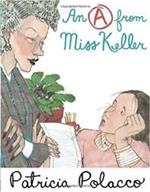 Although most readers are familiar with how this engaging storyteller found affirmation in her art, they will know very little about her formative years as a writer. Relying on pencils and markers for the illustrations, she honors two important teachers in her life. Her writing teacher, Miss Keller, doesn’t give As on writing assignments and sets the bar of expectations high by telling her students to “dazzle me. Impress me. Send me into ecstasy with your brilliance.” Trisha finds solace talking to Pop Schloss, a talented neighborhood baker who provides encouragement. His death helps her find the words to express her feelings powerfully, finally allowing her to meet her teacher’s standards for writing. Not only does the book provide a lovely tribute to teachers, but also Miss Keller’s writing activities are ideal for helping budding writers notice the details in the world around them.
Although most readers are familiar with how this engaging storyteller found affirmation in her art, they will know very little about her formative years as a writer. Relying on pencils and markers for the illustrations, she honors two important teachers in her life. Her writing teacher, Miss Keller, doesn’t give As on writing assignments and sets the bar of expectations high by telling her students to “dazzle me. Impress me. Send me into ecstasy with your brilliance.” Trisha finds solace talking to Pop Schloss, a talented neighborhood baker who provides encouragement. His death helps her find the words to express her feelings powerfully, finally allowing her to meet her teacher’s standards for writing. Not only does the book provide a lovely tribute to teachers, but also Miss Keller’s writing activities are ideal for helping budding writers notice the details in the world around them.
Big Bear Little Chair. Lizi Boyd. 2015. Chronicle.
 Opposites attract, and they make an interesting visual contrast in this color-drenched picture book. Using gouache illustrations and simple text, this book relies on opposites to describe the relationship between Big Bear and Little Bear. Starting with Big Bear and a tiny chair, the book moves all around the place, finally concluding with both bears sitting on the chairs that are the right size for them. This is another winner from the creator of Inside Outside (2013) and Flashlight (2014). Young readers will ask for it to be read aloud repeatedly. Each reread enables readers to notice something different or to see things slightly differently.
Opposites attract, and they make an interesting visual contrast in this color-drenched picture book. Using gouache illustrations and simple text, this book relies on opposites to describe the relationship between Big Bear and Little Bear. Starting with Big Bear and a tiny chair, the book moves all around the place, finally concluding with both bears sitting on the chairs that are the right size for them. This is another winner from the creator of Inside Outside (2013) and Flashlight (2014). Young readers will ask for it to be read aloud repeatedly. Each reread enables readers to notice something different or to see things slightly differently.
Bug in a Vacuum. Mélanie Watt. 2015. Tundra.
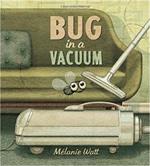 The fact that this picture book from Canada highlights Elizabeth Kubler-Ross’s five stages of grief through the experiences of a fly makes it especially appealing for older readers because it can be read on several levels. When a bug slips into a house, it has many pun-filled adventures (“It was on top of the world when it happened”; unpaged and accompanied by the bug sitting on top of a globe) but ends up trapped in a vacuum cleaner. While pondering its fate and looking for an escape, the poor bug experiences denial, bargaining, anger, despair, and acceptance before finding an unexpected way out. The mixed-media illustrations feature various fascinating visual details, including pesticides and frozen dinners with directions or cautionary messages. Readers will laugh while also pondering life’s events and its cyclical nature as well as those aforementioned stages of grief. The book design is stylish, highly original, and memorable, leaving adults and young readers equally charmed.
The fact that this picture book from Canada highlights Elizabeth Kubler-Ross’s five stages of grief through the experiences of a fly makes it especially appealing for older readers because it can be read on several levels. When a bug slips into a house, it has many pun-filled adventures (“It was on top of the world when it happened”; unpaged and accompanied by the bug sitting on top of a globe) but ends up trapped in a vacuum cleaner. While pondering its fate and looking for an escape, the poor bug experiences denial, bargaining, anger, despair, and acceptance before finding an unexpected way out. The mixed-media illustrations feature various fascinating visual details, including pesticides and frozen dinners with directions or cautionary messages. Readers will laugh while also pondering life’s events and its cyclical nature as well as those aforementioned stages of grief. The book design is stylish, highly original, and memorable, leaving adults and young readers equally charmed.
Emu. Claire Saxby. Ill. Graham Byrne. 2015. Candlewick.
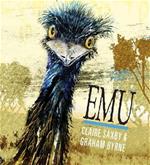 Parenting is handled quite differently among many animal species. In the case of the emu, the female emu has nothing to do with raising the young after she lays the eggs. Because the emu father has much of the caregiving responsibility afterward, the book follows him as he settles down on his nest to keep his little ones warm and then later protects his young. The handsome and eye-catching digital illustrations show how this unusual Australian bird spends its time. The description of the emu’s protective nature is found on one page and additional factual information on the facing page, making this an interesting selection for a science classroom library.
Parenting is handled quite differently among many animal species. In the case of the emu, the female emu has nothing to do with raising the young after she lays the eggs. Because the emu father has much of the caregiving responsibility afterward, the book follows him as he settles down on his nest to keep his little ones warm and then later protects his young. The handsome and eye-catching digital illustrations show how this unusual Australian bird spends its time. The description of the emu’s protective nature is found on one page and additional factual information on the facing page, making this an interesting selection for a science classroom library.
A Fine Dessert: Four Centuries, Four Families, One Delicious Treat. Emily Jenkins. Ill. Sophie Blackall. 2015. Schwartz & Wade.
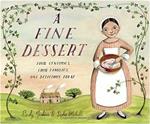 This cross-generational picture book explaining how four families prepare a delicious dessert is simply scrumptious. Spanning four centuries, the book begins in 1710 in Lyme, England, and ends in 2010 in San Diego, CA. Following the dessert’s preparation over four centuries enables readers to detect differences in the way food was prepared during the different eras as well as acknowledging gender roles, slavery, and even what families typically ate during those times. Filled with details, the colorful illustrations, created with Chinese ink, watercolor, and blackberry juice (on the endpapers), will have readers asking for more, more, more. With guidance, young readers will appreciate this succulent treasure even more upon repeated readings.
This cross-generational picture book explaining how four families prepare a delicious dessert is simply scrumptious. Spanning four centuries, the book begins in 1710 in Lyme, England, and ends in 2010 in San Diego, CA. Following the dessert’s preparation over four centuries enables readers to detect differences in the way food was prepared during the different eras as well as acknowledging gender roles, slavery, and even what families typically ate during those times. Filled with details, the colorful illustrations, created with Chinese ink, watercolor, and blackberry juice (on the endpapers), will have readers asking for more, more, more. With guidance, young readers will appreciate this succulent treasure even more upon repeated readings.
Five Nice Mice Build a House. Chisato Tashiro. 2015. Minedition.
 Filled with beautiful and highly detailed illustrations, this picture book follows five creative mice in search of a new home. The basement in which they dwell is not the best location for them because predators and dangers abound, which causes them to look for new digs. They find a most inviting spot in an unlikely place—a dump where people have left their discards. But one person’s trash is another person’s treasure, of course, and these innovative mice cobble together a home complete with all sorts of conveniences that make a house a home. Just as they are settling in, though, they spot a large feline who might threaten their security. As it turns out, he’s helplessly tangled up in twine, leaving him at their mercy. They agree to take a risk and free him. He, in turn, is grateful and guards their property. After all, who doesn’t need a fierce watch cat? Animal lovers will enjoy this tribute to the ingenuity of mice from an up-and-coming Japanese artist whose illustrations are filled with detail.
Filled with beautiful and highly detailed illustrations, this picture book follows five creative mice in search of a new home. The basement in which they dwell is not the best location for them because predators and dangers abound, which causes them to look for new digs. They find a most inviting spot in an unlikely place—a dump where people have left their discards. But one person’s trash is another person’s treasure, of course, and these innovative mice cobble together a home complete with all sorts of conveniences that make a house a home. Just as they are settling in, though, they spot a large feline who might threaten their security. As it turns out, he’s helplessly tangled up in twine, leaving him at their mercy. They agree to take a risk and free him. He, in turn, is grateful and guards their property. After all, who doesn’t need a fierce watch cat? Animal lovers will enjoy this tribute to the ingenuity of mice from an up-and-coming Japanese artist whose illustrations are filled with detail.
Honk! Honk! Hold Tight! Jessica Souhami. 2015. Frances Lincoln Children’s Books.
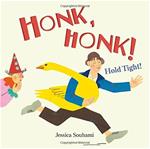 In this picture book originally published in Great Britain, a king is desperate to bring a smile to his daughter’s lips. He promises to share his kingdom with anyone who can do so. A boy named Peter decides to take his goose and see if he can amuse the girl. Before he can do so, though, a woman in need rewards him after he shares his food and water with her. Readers familiar with folk tales will realize right away there’s something magical about the goose, especially when a woman is attached to the goose after she tries to steal one of its feathers. She ends up trailing awkwardly along behind Peter and the goose. As Peter moves through the town, others follow her lead with the same results. The sight of all those men, women, and even a dog following along behind a goose and Peter results in making the princess laugh. Delighted by how Peter has amused her, she suggests that they marry. With interesting details well worth a second look, the illustrations, collages on hand-painted papers using watercolor inks and graphite pencil, accompany the story well.
In this picture book originally published in Great Britain, a king is desperate to bring a smile to his daughter’s lips. He promises to share his kingdom with anyone who can do so. A boy named Peter decides to take his goose and see if he can amuse the girl. Before he can do so, though, a woman in need rewards him after he shares his food and water with her. Readers familiar with folk tales will realize right away there’s something magical about the goose, especially when a woman is attached to the goose after she tries to steal one of its feathers. She ends up trailing awkwardly along behind Peter and the goose. As Peter moves through the town, others follow her lead with the same results. The sight of all those men, women, and even a dog following along behind a goose and Peter results in making the princess laugh. Delighted by how Peter has amused her, she suggests that they marry. With interesting details well worth a second look, the illustrations, collages on hand-painted papers using watercolor inks and graphite pencil, accompany the story well.
In. Nikki McClure. 2015. Abrams.
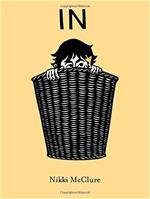 Staying inside is no big deal to an imaginative youngster. After all, he can find lots of things to do as long as he has his stuffed giraffe toy. But when he ventures forth and sees what’s outside, he decides that being outside is just as interesting as being inside. At least that’s the case until he starts feeling cold and wet and longs for the comfort of his bed. Following the boy as he goes from one activity to the next, entertaining himself and even using a basket as a rocket ship in which to travel, the interesting illustrations were created by cutting black paper. Readers may enjoy the visual contrast provided through the use of black, white, and yellow colors.
Staying inside is no big deal to an imaginative youngster. After all, he can find lots of things to do as long as he has his stuffed giraffe toy. But when he ventures forth and sees what’s outside, he decides that being outside is just as interesting as being inside. At least that’s the case until he starts feeling cold and wet and longs for the comfort of his bed. Following the boy as he goes from one activity to the next, entertaining himself and even using a basket as a rocket ship in which to travel, the interesting illustrations were created by cutting black paper. Readers may enjoy the visual contrast provided through the use of black, white, and yellow colors.
Moletown. Torben Kuhlmann. 2015. NorthSouth.
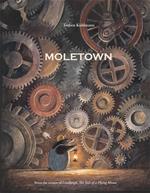 This talented author/illustrator from Germany impressed readers greatly with Lindbergh (2014), and this follow-up is equally impressive. One mole decides to move underground, leaving the lush greenery of the outside world behind for the joys of tunneling underground. But, slowly, things aboveground become out of hand. Industrialization, progress, and damaging environmental practices take a toll on the once-thriving and visually appealing Moletown, leaving its residents with only a very small patch of land that has not been spoiled by progress. Clearly, while building and renovation have their places, progress has taken a toll on the environment, making this a humorous but stark reminder of what may lie ahead for humans and the world around them. The illustrations are filled with exhausted workers, congested streets, and air that is hard to breathe. Readers will be impressed by this artist’s vision and perhaps pay attention to his caution about too much change in the name of progress.
This talented author/illustrator from Germany impressed readers greatly with Lindbergh (2014), and this follow-up is equally impressive. One mole decides to move underground, leaving the lush greenery of the outside world behind for the joys of tunneling underground. But, slowly, things aboveground become out of hand. Industrialization, progress, and damaging environmental practices take a toll on the once-thriving and visually appealing Moletown, leaving its residents with only a very small patch of land that has not been spoiled by progress. Clearly, while building and renovation have their places, progress has taken a toll on the environment, making this a humorous but stark reminder of what may lie ahead for humans and the world around them. The illustrations are filled with exhausted workers, congested streets, and air that is hard to breathe. Readers will be impressed by this artist’s vision and perhaps pay attention to his caution about too much change in the name of progress.
The Most Amazing Creature in the Sea. Brenda Z. Guiberson. Ill. Gennady Spirin. 2015. Henry Holt.
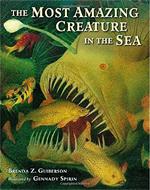 Based on the eye-catching cover of an anglerfish and the book’s title, readers might be excused for thinking the author is going to provide the definitive answer to which sea creature is most intriguing. But she doesn’t; instead, as was the case in her earlier book, The Greatest Dinosaur Ever (2013), she offers a baker’s dozen of amazing creatures found in the ocean’s depths and then makes a case for why each one is the most amazing. From the Box Jellyfish on the book’s opening pages to the maritime helpers near the conclusion, the amazing, highly detailed illustrations rendered with tempera, watercolor, and pen will have readers absolutely glued to the book’s pages. The book is designed with an “I am...” statement on the first page about the animal, and a description under a huge two-page illustration of each fascinating creature, concluding with “That’s why I am the most amazing creature in the sea.” This gorgeous and fact-filled book will have readers arguing over their favorites.
Based on the eye-catching cover of an anglerfish and the book’s title, readers might be excused for thinking the author is going to provide the definitive answer to which sea creature is most intriguing. But she doesn’t; instead, as was the case in her earlier book, The Greatest Dinosaur Ever (2013), she offers a baker’s dozen of amazing creatures found in the ocean’s depths and then makes a case for why each one is the most amazing. From the Box Jellyfish on the book’s opening pages to the maritime helpers near the conclusion, the amazing, highly detailed illustrations rendered with tempera, watercolor, and pen will have readers absolutely glued to the book’s pages. The book is designed with an “I am...” statement on the first page about the animal, and a description under a huge two-page illustration of each fascinating creature, concluding with “That’s why I am the most amazing creature in the sea.” This gorgeous and fact-filled book will have readers arguing over their favorites.
Sad, the Dog. Sandy Fussell. Ill. Tull Suwannakit. 2015. Candlewick.
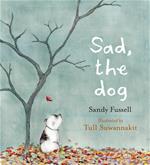 A lonely, unloved dog receives basic care from his family, but not a lot of love. In fact, he ends up christening himself “Sad” because that’s how he feels. His human companions ignore him when they aren’t yelling and scolding, and when they finally move, they leave him behind. But a new family with a friendly boy befriends him, and eventually Sad learns to trust again. This family seems to understand dogs, and Jack and the newly-named “Lucky” frolic outdoors, playing with paper airplanes and digging in the dirt, all the things he had been forbidden to do before. This picture book from Australia is a vivid reminder of how much animals learn from humans as well as what humans can learn from animals. Sad is, indeed, very Lucky once the right person befriends him. Those animal “owners” who behave irresponsibly, never allowing their dogs to play or even deserting them need to read this book as a reminder that animals matter and have feelings.
A lonely, unloved dog receives basic care from his family, but not a lot of love. In fact, he ends up christening himself “Sad” because that’s how he feels. His human companions ignore him when they aren’t yelling and scolding, and when they finally move, they leave him behind. But a new family with a friendly boy befriends him, and eventually Sad learns to trust again. This family seems to understand dogs, and Jack and the newly-named “Lucky” frolic outdoors, playing with paper airplanes and digging in the dirt, all the things he had been forbidden to do before. This picture book from Australia is a vivid reminder of how much animals learn from humans as well as what humans can learn from animals. Sad is, indeed, very Lucky once the right person befriends him. Those animal “owners” who behave irresponsibly, never allowing their dogs to play or even deserting them need to read this book as a reminder that animals matter and have feelings.
Thank You, Jackson: How One Little Boy Makes a BIG Difference. Niki Daly. Ill. Jude Daly. 2015. Frances Lincoln Children’s Books.
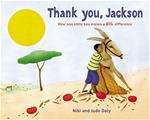 For years, a donkey named Jackson has patiently and obediently carried a farmer’s wares to the market, but one day he decides not to do so. In his own quiet way, he stages a sit-down strike and refuses to budge. His owner is furious, and he pushes, pulls, and yells at him to get him to move. Just before he strikes Jackson, at his wife’s request, his son intervenes by whispering in Jackson’s ear. The donkey immediately rises, and all three head to market, dividing the load equally. Thanks to his son, the chastened farmer may treat Jackson much better and show how much he values his work. Youngsters will learn important lessons about how words such as please and thank you can make all the difference in the world. Although it’s easy to understand the farmer’s frustration, his anger failed to make any difference in his donkey’s behavior. As is often the case, in the end, a soft word and a little appreciation reap bounteous reward.
For years, a donkey named Jackson has patiently and obediently carried a farmer’s wares to the market, but one day he decides not to do so. In his own quiet way, he stages a sit-down strike and refuses to budge. His owner is furious, and he pushes, pulls, and yells at him to get him to move. Just before he strikes Jackson, at his wife’s request, his son intervenes by whispering in Jackson’s ear. The donkey immediately rises, and all three head to market, dividing the load equally. Thanks to his son, the chastened farmer may treat Jackson much better and show how much he values his work. Youngsters will learn important lessons about how words such as please and thank you can make all the difference in the world. Although it’s easy to understand the farmer’s frustration, his anger failed to make any difference in his donkey’s behavior. As is often the case, in the end, a soft word and a little appreciation reap bounteous reward.
Up in the Garden and Down in the Dirt. Kate Messner. 2015. Ill. Christopher Silas Neal. Chronicle.
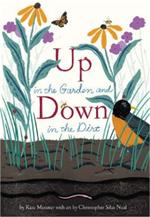 Lovely mixed-media illustrations highlight the pleasures of gardening, allowing readers to revel in the passage of time and make note of the activities that are occurring beneath the soil’s surface during the course of a year. From checking the soil for its readiness for planting to sowing seeds and plants to finally harvesting them and returning to the dormancy of winter again, readers will surely have the chance to ponder how “a whole new garden sleeps down in the dirt.” Anticipating each phase in the growing season adds to the delights of reading this book as do the thumbnail sketches describing the animals that are so helpful in making sure the garden is healthy. The author’s acknowledgement of the unsung heroes who tend community gardens throughout the year adds to the personal quality and makes it ideal for science classrooms, especially those planning their own community gardens. After all, the book offers excellent coming attractions for what youngsters can expect when they try to grow something.
Lovely mixed-media illustrations highlight the pleasures of gardening, allowing readers to revel in the passage of time and make note of the activities that are occurring beneath the soil’s surface during the course of a year. From checking the soil for its readiness for planting to sowing seeds and plants to finally harvesting them and returning to the dormancy of winter again, readers will surely have the chance to ponder how “a whole new garden sleeps down in the dirt.” Anticipating each phase in the growing season adds to the delights of reading this book as do the thumbnail sketches describing the animals that are so helpful in making sure the garden is healthy. The author’s acknowledgement of the unsung heroes who tend community gardens throughout the year adds to the personal quality and makes it ideal for science classrooms, especially those planning their own community gardens. After all, the book offers excellent coming attractions for what youngsters can expect when they try to grow something.
Barbara A. Ward teaches graduate and undergraduate courses in literacy at Washington State University, Pullman. She spent 25 years teaching in the public schools of New Orleans, where she worked with students at every grade level, from kindergarten through high school as well as several ability levels. She is certified in elementary education, English education, and gifted education. She holds a bachelor's in communications and a master's in English Education from the University of Tennessee and a PhD in Curriculum and Instruction from the University of New Orleans.
These reviews are submitted by members of the International Reading Association's Children's Literature and Reading Special Interest Group (CL/R SIG) and are published weekly on Literacy Daily.